By NGC Ancients …..
The royal busts of the Indo-Greek kings are often adorned with unusual helmets and headdresses
Among the most interesting and diverse portraits on ancient ‘Greek’ coinage are those of the Indo-Greek kings of Bactria, a region on the fringe of the Greek world. In addition to the portraits themselves, which many times have expressive and highly individualized features, these royal busts often are adorned with unusual helmets and headdresses.
For a base line we’ll start with a Bactrian portrait coin that has a ‘normal’ portrait – one adorned only with a royal diadem, a head band worn by Greek kings. Below is a silver tetradrachm of King Agathocles (c.185-180/70 BCE) with just such a portrait.
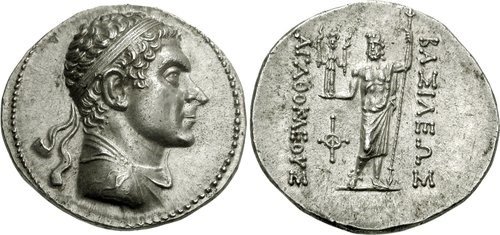
Agathocles Tetradrachm
Perhaps topping the list of unusual head adornments in Bactria is the elephant scalp. It is best known on the coins of King Demetrius I (c.200-185 BCE), which are readily available to collectors. The one illustrated here, a silver tetradrachm, shows a detailed image of the elephant scalp, with the ears, eyes, trunk and tusks all engraved in a realistic manner. Note the royal diadem that overlaps the bottom edge of the scalp.

Demetrius I Tetradrachm
King Lysias (c.130-125 BCE) also issued coins on which he portrays himself wearing an elephant scalp. The coin shown below, a silver drachm, is smaller than the earlier tetradrachm of Demetrius I, so the detail is less fully realized. None the less, the royal diadem is still clear.
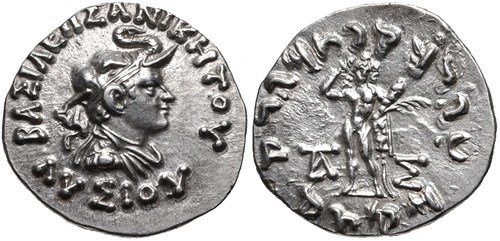
Lysias Drachm
These Bactrian versions very likely were derived from an earlier coinage struck by Ptolemy I, who ruled Egypt after the death of Alexander III the Great, initially as satrap (323-305/4 BCE), and then as king (305/4-282 BCE). Though the meaning of this headdress has been much discussed, it seemingly reflects the successes that Alexander III enjoyed during his eastern campaigns.
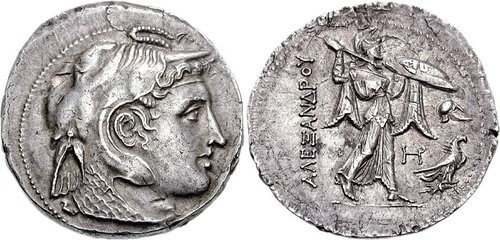
Ptolemy I
Next is the petasus or causia, a distinctive Greek hat made of a soft material that was used primarily as a sun hat. Despite this rather humble, rural associations, it was worn by the messenger-god Hermes, and at different times was donned by Greek kings. Shown below is a tetradrachm of the Bactrian king Antimachus I (c.180-165 BCE), who portrayed himself wearing a petasus and his royal diadem.
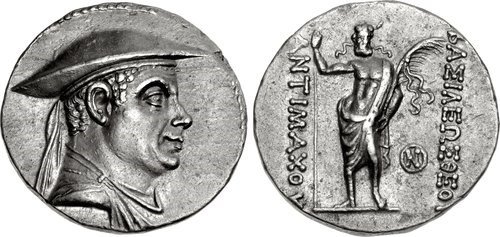
Antimachus Tetradrachm
Also shown wearing a petasus and a diadem is King Apollodotus I (c.180-160 BCE). It is interesting to note how this king wears his cap tilted more upright than did his contemporary Antimachus I. This gives the portrait an entirely different appeal.

Apollodotus I Tetradrachm
The petasus appears on numerous other coins of the Greek world, including the silver triobol, shown below, which was struck c.250-145 BCE by the Aetolian League in central Greece. In this case the petasus adorns the head of the personification of the region of Aetolia.
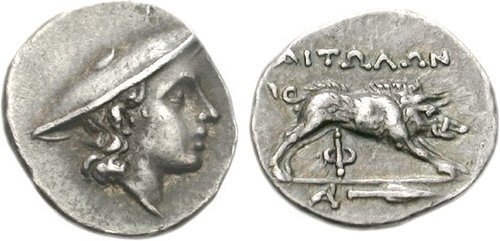
Aetolian League Triobol
Many other portraits of Bactrian kings are adorned with a helmet, though in this far-flung region the helmet of choice was not of the familiar Attic or Corinthian type, but one that very closely resembles a pith helmet that achieved such great popularity in the British Empire in the late 19th and the early 20th Centuries. Shown below is a silver tetradrachm on which this type of helmet is worn by King Eucratides I (c.170-145 BCE).
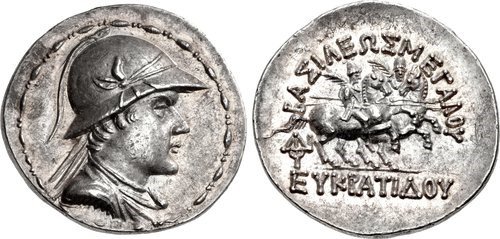
Eucratides Tetradrachm
Unlike the much later British version, we might presume the Bactrian version shown on coins was made of metal. On this depiction the top of the helmet is adorned with a horse-hair crest, and the tails of the royal diadem are seen trailing from the back. Below are drachms of King Menander (c.165/55-130 BCE), who wears a more decorative version, and the aforementioned King Lysias, whose helmet more closely resembles the version used by Eucratides.
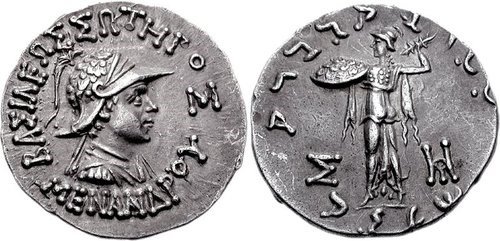
Menander Drachm
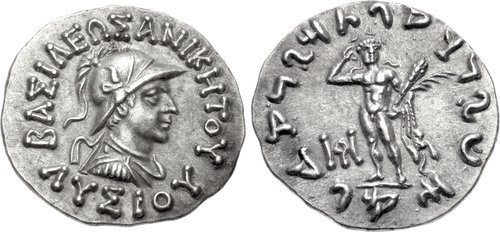
Lysias Drachm
Images courtesy of Classical Numismatic Group, Inc (CNG)




